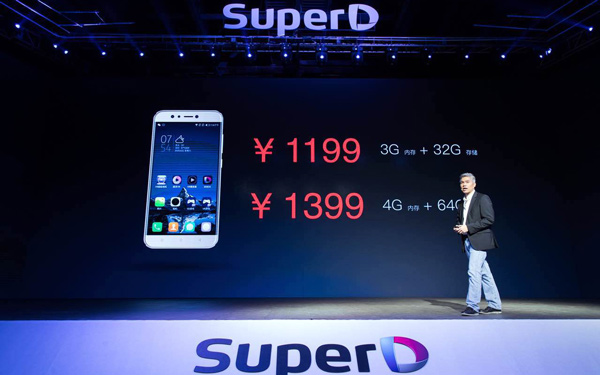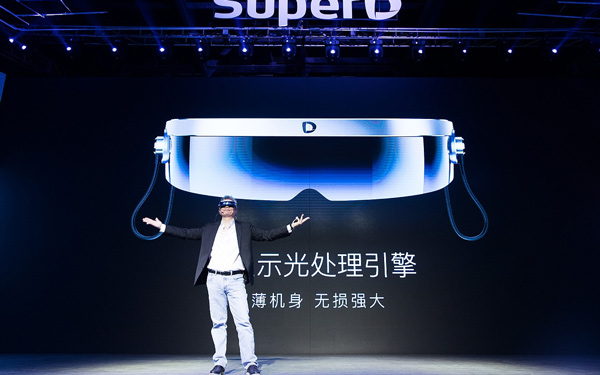 |
|
Michael Hsu, CEO of SuperD, delivers a keynote speech on September 5, 2016 during the company's products launch event held in Beijing. [Photo provided to chinadaily.com.cn] |
Shenzhen-based technology company SuperD Technology recently hosted a conference in Beijing, announcing the launch of the world's first full display handset -- a smartphone that integrates 2D, 3D and virtual reality (VR) content display in one piece.
Dubbed the SuperD D1, the phone is recognized as the first of its kind to deploy the concept of a full display mobile phone that can seamlessly switch between 2D, 3D and VR modes.
 |
|
Michael Hsu, CEO of SuperD, delivers a keynote speech on September 5, 2016 during the company's products launch event held in Beijing. [Photo provided to chinadaily.com.cn] |
According to the company, the innovation in creating the solution took place when the SuperD VR motion-sensing vision chip was added to the preconfigured GPU of a traditional cell phone, which enhanced the rendering speed of the 3D and VR images through the integration of the 3D/VR algorithm. It resolved the issue of the slow calculation that takes place when reproducing complex images, reduced image latency to a minimum and allowed the creation of corresponding body sensation, resulting in clear and precise images.
SuperD's chief?executive Michael Hsu says the technology gap between the rapidly booming VR vendors in China hardly exists. He noted that high quality content was the magic factor that would win customers' loyalty.
"We've been speeding up interactive content building, and by introducing the SuperD VR content and Meidou live TV platform, we're able to provide huge storage of 3D and VR resources, including a massive number of 3D movies, hundreds of 3D/VR games, thousands of VR videos and numerous 3D/VR applications," Hsu said.
 |
|
Michael Hsu, CEO of SuperD, delivers a keynote speech on September 5, 2016 during the company's products launch event held in Beijing. [Photo provided to chinadaily.com.cn] |
The company provides more than 300 long and short videos in its hardware, either from authorized sources or as user-generated content.
Moreover, the technology in the SuperD D1 camera goes beyond the rear dual camera technology applied to traditional smartphones, deploying a front dual camera, with one of the cameras recording the images and the other tracking the exact position of the user's eyes. It allows customization and the simultaneous generation of visual images based on the precise position of the eyes, as well as the interpupillary distance (IPD, or precise distance between the centers of the user's two pupils).
No matter which way and in which direction the user moves, a clear 3D visual sensation will be delivered throughout the experience.
As a company which has evolved from B2B to B2C in recent years, Hsu said the company's new hardware would not be expanded overseas until it secures its position in the domestic market.
"We've established a certain number of partnerships with overseas enterprises and the experience will boost the business expansion in certain areas," Hsu said.
Another two VR products, including the SuperD VR ZERO Helmet and SuperD VR ONE, an all-in-one VR display, were also introduced at the event.
The company said in a statement that it plans to apply the advantages of VR and 3D technologies to a wide array of consumer products and services encompassing mobile hardware, games, movies, TV and live broadcast events, creating a closed-loop ecology which simultaneously includes the development of hardware, software and content based on technological innovation.
From the mobile industry's perspective, Jin Ruizhao, associate research director of telecom division of GfK China told China Daily that the key elements that enable it to implement innovative ideas are user scenarios, technological maturity and brand influence.
"The specific 3D visual impact provided by a smartphone, rather than a cinema screen, may be reduced due to the much smaller size of the display and watching the content for a long period of time may cause fatigue as well," said Jin.
He predicted that SuperD will be welcomed by tech savvy users and early adaptors while he expressed cautious optimism about the products' future popularization, saying the back-end technology may be considered a substantial upgrade, rather than a groundbreaking innovation.
Jin Di, research manager at the client system research department of IDC China, noted that the SuperD D1 reflects a transformation happening in the smartphone industry as more functions are implemented in handsets to target segmented markets.
"With the size of the smartphone's display increasing, additional functions of a handset, such as entertainment, will be considered when consumers purchase the product," said Jin. "The combination of VR or AR with the smartphone will be a future trend in the sector."
"The eco-systems building?on?both products driven by 3D and VR technology require a large number of application developers as well as scenarios that enable?them to reach the pain points of consumers," said Neo Zheng, another research manager at the client system research department of IDC China, who specialized in VR sector. "Some of the user experiences, such as the 'depth of field' effect, are not easy for a cardboard-like VR goggle to achieve at the moment."
